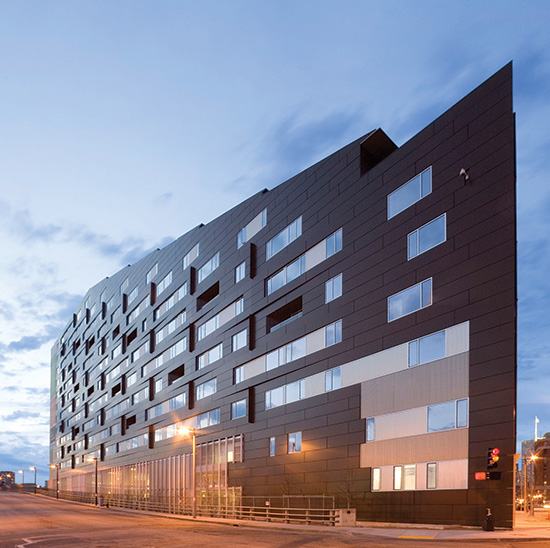Achieving Higher Quality in High-Density Residential: the Strengths of Structural Steel
Staggered Truss
The structural concept for the staggered truss system was developed with flexibility in mind, as column-free and beam-free spaces 30 feet by 60 feet or larger are possible. Story height trusses are typically spaced 60 feet apart, running along the short dimension of the building and alternating on column grid lines on every other floor. With the alternating, or staggering, structure, the building contains fewer structural elements which enhances the speed of construction and reduces loads on the foundation compared to an all-concrete frame. Trusses allow for horizontal penetrations as needed for mechanical, plumbing, electrical and fire protection. Precast hollow core plank flooring is commonly used and allows for floor-to-floor heights as low as 8 feet 9 inches. Repetitive truss designs are economical and efficient for the structural system, easily accomplished with the same floor-to-floor heights and stacked unit layouts. Hanging the second floor from the level above allows for a ground floor free of interior columns. Ideal for buildings greater than five stories, the speed of construction is known for saving time in the project schedule and as a benefit to owners desiring early occupancy.
A common design challenge is addressing an efficient parking grid that is coordinated with residential floor plates above. Transferring structure to accommodate residential unit modules above a parking grid often comes at a cost. The staggered truss system eliminates the need for structural transfer levels, which often take up critical space, and works well in mixed-use building types that include parking, high-density residential and hotel occupancies.
There is a long history of buildings which take advantage of the vast amount of clear floor space offered by the staggered truss framing system. Towers on the Park consists of a nine-story and 20-story building and was one of the first large apartment buildings in New York City to use the staggered truss system in 1986. A luxury vacation complex of five- to seven-story buildings, the Seascape Point Condominiums in Osage Beach, Missouri, was completed in 2006 along Lake of the Ozarks. In 2007, the Macallen Building Condominiums offered 140 luxury units in the Boston market with distinct floor plans that were integrated with the staggered truss system. The Summer House apartments will be a 22-story building comprised of 226 units, five levels of parking, and ground level retail and restaurant space in downtown Stamford, Connecticut.

Image courtesy of Stantec Architecture in association with Office DA
Macallen Building Condominiums, Boston, Massachusetts. The exterior fins represent the locations of story height staggered trusses that span across each floor.









